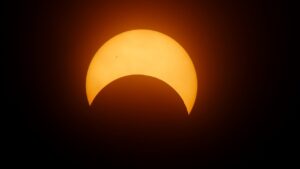As FWBG | BRIT begins its ¡Celebramos! events, you might notice one flower taking center stage: marigolds. These brightly colored yellow or orange blooms are closely associated with Dia de los Muertos, or Day of the Dead, celebrations in Mexico, Texas and throughout the world on November 1 and 2.
The Mexican or Aztec marigold has been used for centuries in Mexico to represent the fragility of life. Known in the Nahuatl language spoken by the Aztecs as cempasuchil, the flowers are native to Central Mexico and have been cultivated since ancient times. Their bright color and pungent odor are said to attract spirits, who are believed to return to visit their families during this time. Families pile marigolds onto altars, weave them into garlands and sometimes use petals to create pathways to guide the spirits.
Other cultures also celebrate with marigolds. In India, the flowers are associated with the sun; they are often strung into garlands that hang over doorways of homes and are used to decorate wedding ceremonies. In Thailand, marigolds symbolize good luck and prosperity and are frequently left as offerings at Buddhist temples.
While lacking the religious significance they are granted in many parts of the world, marigolds are also a favorite of many north Texas gardeners. “Marigolds are a great option for adding a pop of bright color to your landscape,” says Sr. Horticulturist Steve Huddleston. “They’re reliable performers for the fall garden.”
Nurseries generally stock two main varieties. The first are French marigolds (Tagetes patula), which despite their name are not from France. These are fairly short (growing six to 18 inches tall), mounding plants with flowers up to two inches across. They like full sun and well-drained soil. They thrive in both beds and containers.
The second are African marigolds (Tagetes erecta), which, again, are not actually from Africa but native to Mexico and Central America. They are taller than French marigolds (growing up to three feet tall) with flower heads up to six inches in diameter. They also prefer full sun but better tolerate dry conditions and poor soil.
Many people plant marigolds in the spring, and they can bloom all summer. However, in the summer they are susceptible to spider mites, which can be difficult to treat.
“What I prefer is to plant marigolds at the end of the summer—in late August or September,” says Huddleston. “They are not susceptible to spider mites then, they thrive as the temperatures drop and will look beautiful until the first frost.”
In fact, Huddleston believes marigolds are a good substitute for mums in the fall garden, since mums bloom for only two or three weeks. “Marigolds make a great fall crop. They look superb in combination with fall décor such as bales of straw, cornstalks and pumpkins.” Whatever your reason for loving marigolds, they can be a great addition to your garden.







